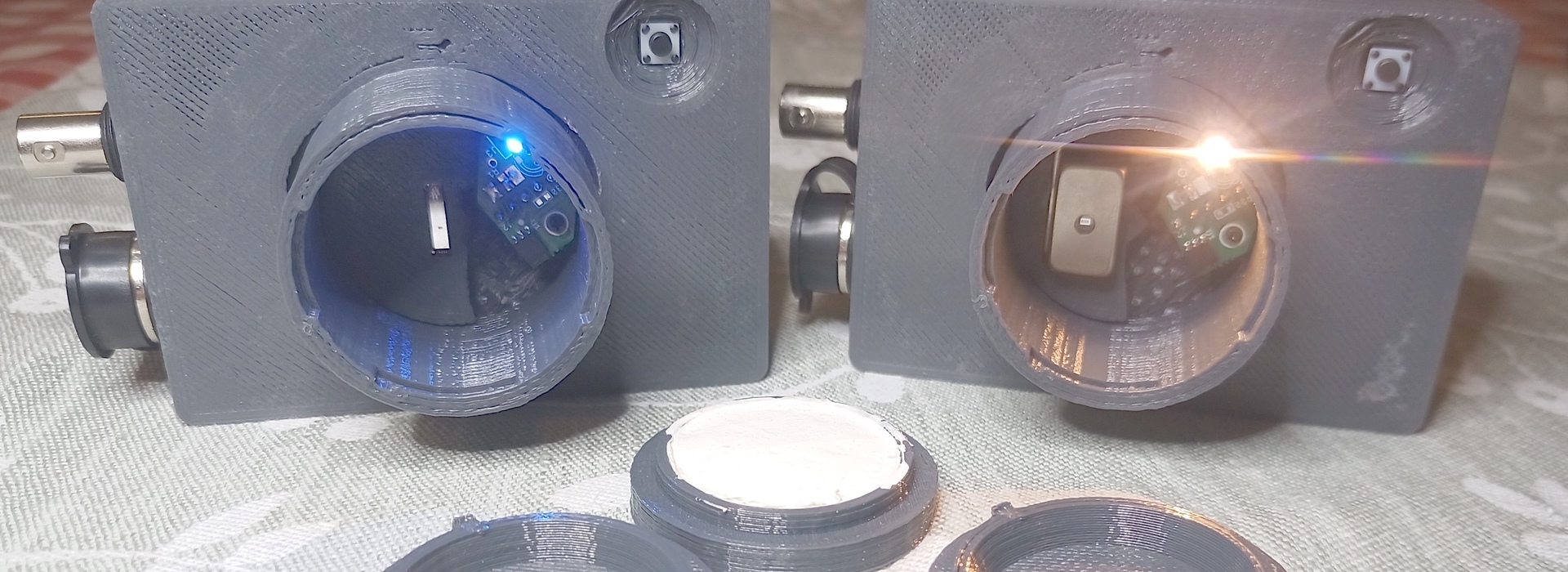

xSpectrolum+ v080 is built around a customized Printed Circuit Board (PCB) enclosed in a 3D printed shell. It comes with either a visible (VIS) or a near infra-red (NIR) spectral sensor. Dependent on the spectral range and the type of sample (solid or liquid), a range of exchangeable "muzzles" are attached using a bayonet joint.
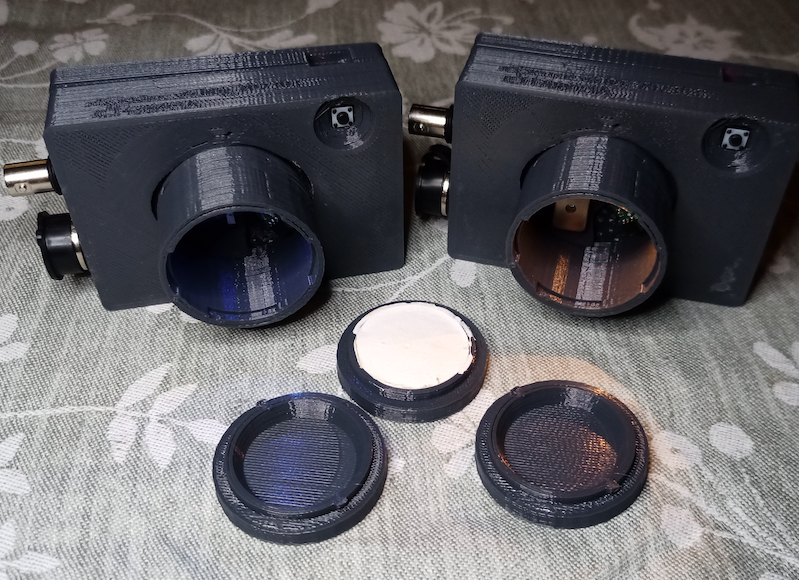
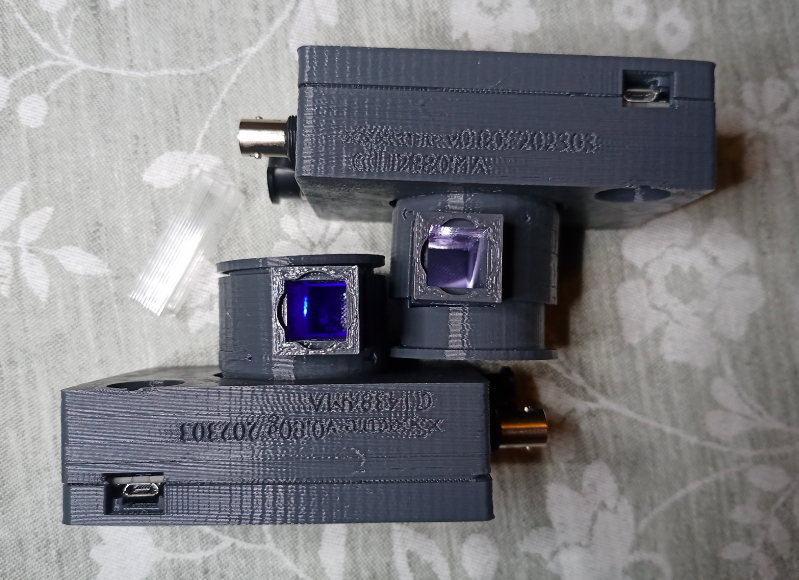
xSpectrolum+ further comes with a range of external (+) sensors, or probes (to separate the spectral sensor from other measuring devices we call the latter probes). The external probles are of 4 different main types:
The external probes can be used both for direct soil testing and for locally adjusting the prediction of soil properties from signal for the spectral sensor.
The central part of xSpectrolum+ v0.80 is a customized Printed Circuit Board (PCB) with an attached microcontroller and a LiPo battery, figure 1. These components are fitted into a 3D printed shell that is composed of two parts. When fitted the PCB slides into the bottom part of the shell, that then becomes the spectrometer front (see page top figure), and the lock, that also fits the battery, becomes the spectrometer back.
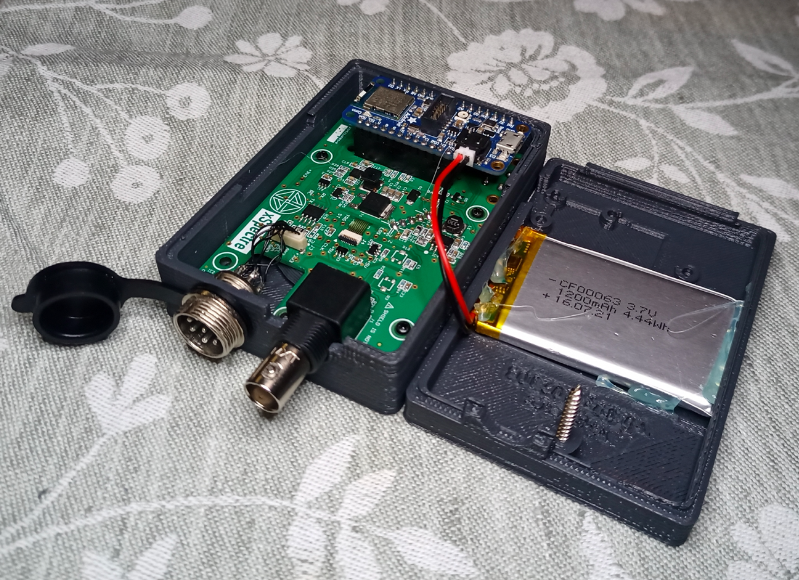 Figure 1. Inside of the xSpectrolum+ v0.80.
Figure 1. Inside of the xSpectrolum+ v0.80.
Version 0.80 of the xSpectrolum+ series of spectrometers is built to carry any of the following three Hamamatsu miniature spectral sensors:
The first two sensors (C12666MA and C12880MA) come with identical casings (the left sensor in figure 2 below). All three are grating type spectral sensors.
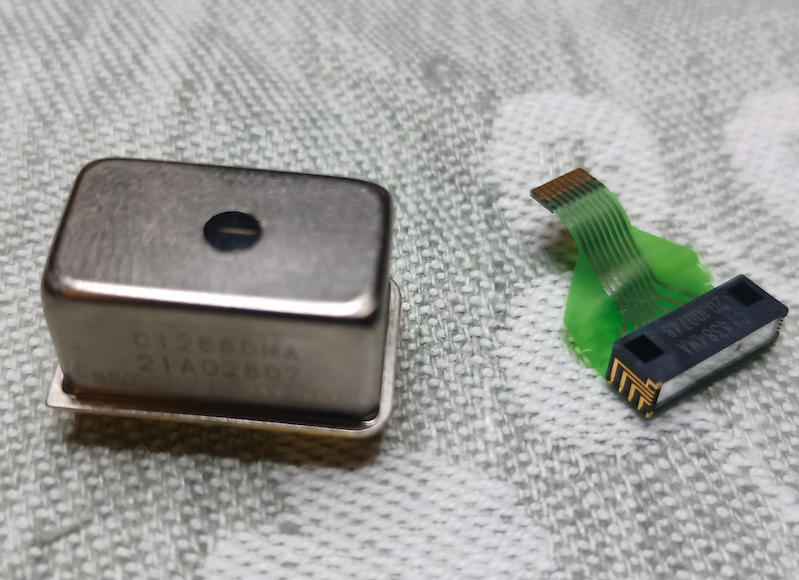 Figure 2. Hamamatsu miniature spectral sensors that can be used with xSpectrolum+ v080; left: C12880MA (with C12666MA having an identical casing), and right: C14384MA-01.
Figure 2. Hamamatsu miniature spectral sensors that can be used with xSpectrolum+ v080; left: C12880MA (with C12666MA having an identical casing), and right: C14384MA-01.
The three Hamamatsu spectral sensors are operated using similar pins and principles. Hence we created a PCB (speclum) that can host any of the three Hamamatsu sensors. The PCB does not have an integrated microcontroller, instead it is built for attaching the Adafruit Feather nRF52840 express microcontroller. The speclum (main) PCB does further not include any light source, these are attached using a 3D printed bayonet joint integrated in the shells of the spectrometer and muzzle shells, and connected via a smaller (ledlum) PCB (see figures 3 and 4). A 5-pin pogo connection is used for power and electronic signal transmission. That allows using the same basic spectrometer to be used for different spectral analysis (e.g. diffuse reflectance spectroscopy of solids, fluorescence spectroscopy of both solids and liquids and transmissivity spectroscopy of liquids and thin-sliced solids).
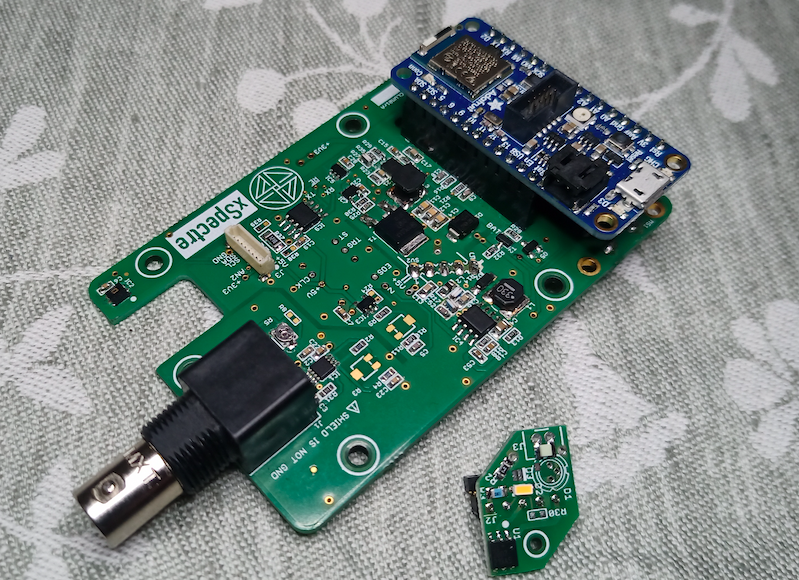 Figure 3. xSpectrolum+ v080 is built on a customized PCB (speclum) with light sources attached via a smaller (ledlum) PCB, both enclosed in 3D printed casings; Adafruit Feather nRF52840 express is used as microcontroller.
Figure 3. xSpectrolum+ v080 is built on a customized PCB (speclum) with light sources attached via a smaller (ledlum) PCB, both enclosed in 3D printed casings; Adafruit Feather nRF52840 express is used as microcontroller.
Figure 4 shows the pogo pins, with the male on the speclum PCB and the female on the ledlum PCB. As seen in the figure the pogo pins are attached to the backside of the PCBs.
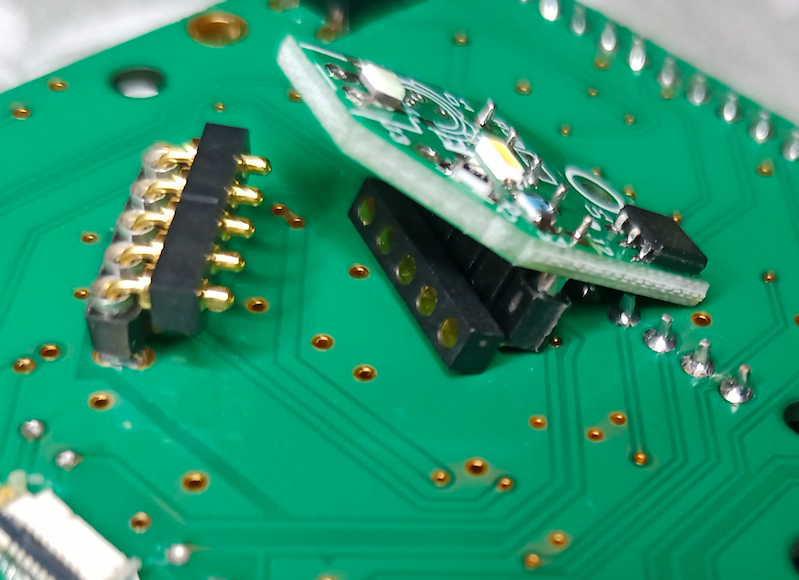 Figure 4. Pogo pins connecting body (speclum) and muzzle (ledlum).
Figure 4. Pogo pins connecting body (speclum) and muzzle (ledlum).
All shells, locks, other casings and holders are 3D printed. To be able to accommodate the different spectral sensors, sample types and light sources, all with their different locks and other paraphernalia, a total of approximately 20 different 3D printed items are required.
The two most important 3D parts are the xSpectrolum+ body shell (bottom and lock) and the muzzles. The design of the body shell bottom part depends on the spectral sensor; the type of muzzle on the kind of sample to analyze (solid, liquid or gaseous). Figure 5 shows the two different types of 3D printed body shells for accommodating the different Hamamatsu sensors.
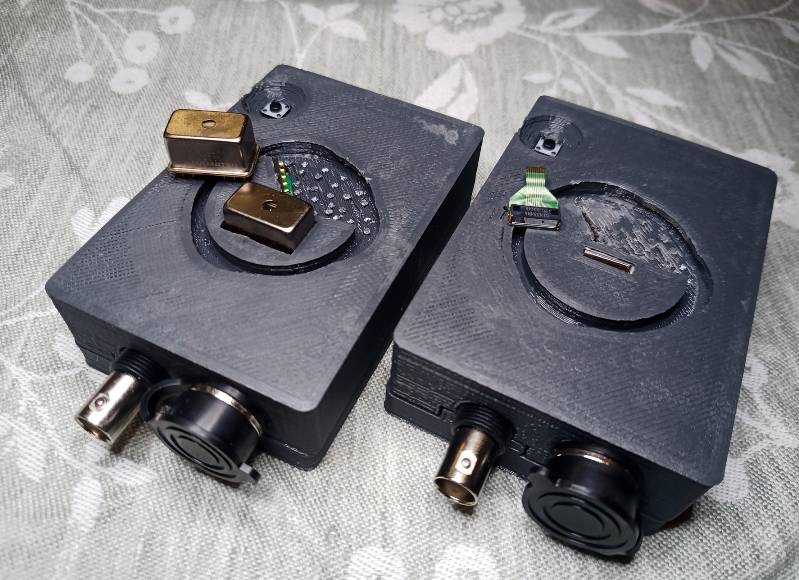 Figure 5, Body parts for two alternative Hamamatsu spectral sensors; left: C12880MA/C12880MA for visible light, and right: C14384MA-01 for near infra-red light.
Figure 5, Body parts for two alternative Hamamatsu spectral sensors; left: C12880MA/C12880MA for visible light, and right: C14384MA-01 for near infra-red light.
Figure 6 shows the muzzles for solid (granulated) and liquid samples. The latter are composed of two individally 3D printed parts: a bayonet joint with a cylinder having a cut-out rectangle, and a cuvette holder that fits in the cut-out. The cuvette holder further comes in two different versions; one for transmissivity with the light source positioned opposite the spectral sensors, and one for fluorescence with the light (laser) source at right angle to the spectral sensor.
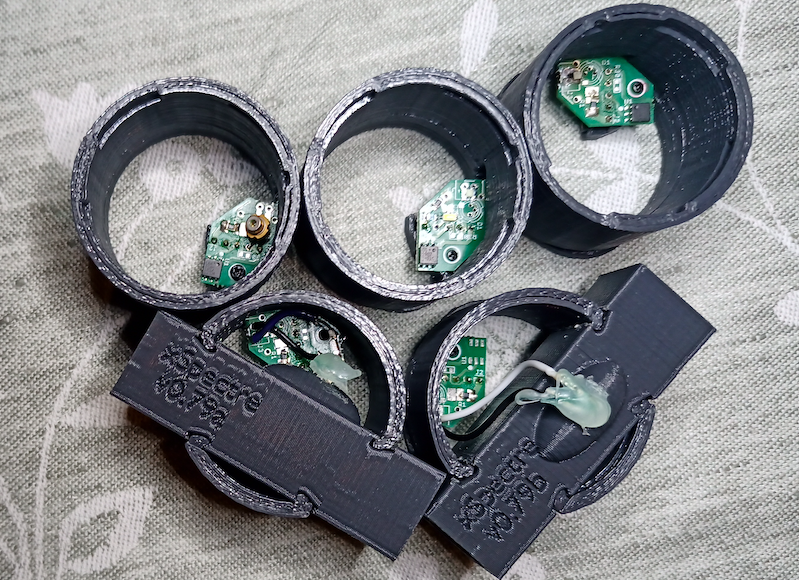 Figure 6, Muzzles for different spectral methods; top row: for solid or granulated samples (with fluorescence empolying an UV laser in the left muzzle, and diffuse reflectance empolying VIS and NIR led light sources as in the middle and right muzzles ), bottom row: fluorescence of liquids (with light source at right angle to spectral sensor, left) and transmissivity of liquids or thin sliced solids (with light source opposite spectral sensor, right).
Figure 6, Muzzles for different spectral methods; top row: for solid or granulated samples (with fluorescence empolying an UV laser in the left muzzle, and diffuse reflectance empolying VIS and NIR led light sources as in the middle and right muzzles ), bottom row: fluorescence of liquids (with light source at right angle to spectral sensor, left) and transmissivity of liquids or thin sliced solids (with light source opposite spectral sensor, right).
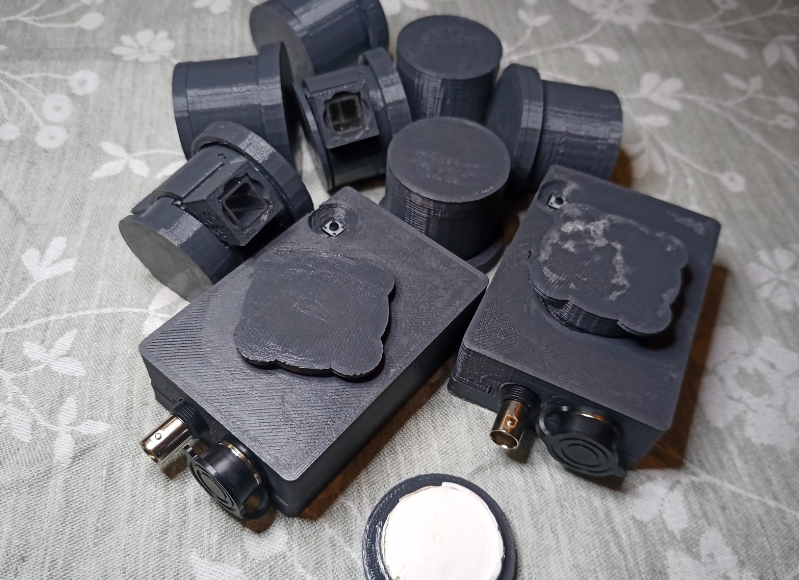 Figure 7, Locks for protecting the opto-electonic components; the muzzle lock filled with white at the bottom is a white diffuse reflectance standard.
Figure 7, Locks for protecting the opto-electonic components; the muzzle lock filled with white at the bottom is a white diffuse reflectance standard.
xSpectrolum+ has builtin external ports that allow additional sensors and probes to be added, thus the +. External sensors include stainless steel probes for soil field sampling (for example of humidity, salinity, pH and NPK) and laboratory Ion Selective Electrodes (for example for pH, NO3-, NH4+, K+, Ca2+). The external probes convert xSpectre's spectrometer from a light sensor to a Swiss army knife for soil sensing.
Steel-pin soil field probes
Over the past years a new range of soil field probes have appeared for rapid soil assessment. These probes are all based on steel pins, between 5 and 10 cm long, and resin sealed and waterproof bodies (grade IP68) with internal electronics. Only recently have these probes become available for operation at 5 volt and thus applicable for use with the kind of microcontollers employed in the xSpectrolum+ (figure 8).
The most common type is the 3-pinned temperature, soil-moisture and salinity probe, that can also sense total dissolved solids and epsilon (the soil di-electric constant). The 3-pinned probe for Nitrogen (N), Phosphorus (P) and Potassium (K), abbreviated NPK, has only recently become avalilable for operation at 5 volt. The 2-pinned pH sensor is also a newcomer. The most recent addition to this family of probes is the 5-pinned version that can sense all of the mentioned soil properties.
These steel-pinned field probes are attached to xSpectrolum+ via the GX16 plug, figure 8. The communication with the xSpectrolum+ microprocessor is via rs485/modbus standard and protocol.
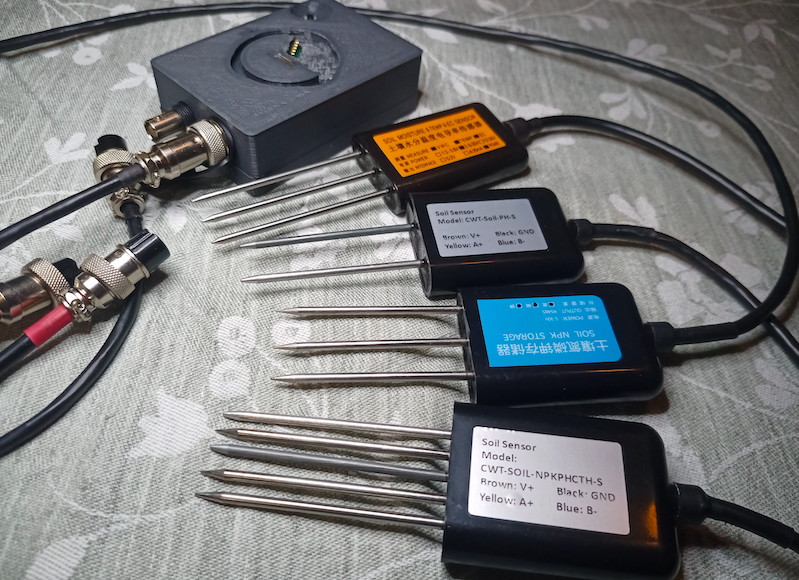 Figure 8, Field probes for soil properties that can be operated with xSpectrolum+. The frontmost probe can sense all the parameters of the other three combined (blue body: NPK; silver-grey body: pH; orange body: temperature, soil moisture, electric conductivity and salinity).
Figure 8, Field probes for soil properties that can be operated with xSpectrolum+. The frontmost probe can sense all the parameters of the other three combined (blue body: NPK; silver-grey body: pH; orange body: temperature, soil moisture, electric conductivity and salinity).
Ion Selective Electrodes
Ion Selective Electrones (ISE) are laboratory grade probes that measure the activity of targeted ions. ISEs are available from a range of different suppliers and are of different kinds and quality. ISEs typically use a BNC (coaxial) connector. As the xSpectre spectrometer+ is equipped with a BNC connector, most ISEs can be used directly with xSpectrolum+ (figure 9).
The most common, and also easy to use, is the pH ISE. It is more stable and usually quick and easy to calibrate compared to other ISEs. However, also the pH ISE requires calibrations solutions for adjusting the signal to actual pH values.
Apart from pH, other ISEs relevant for sensing soil health and fertility include NO3-, NH4+, K+ and Ca2+. A range of other ISEs are available for particular ions and could be relevant for screening for e.g. particular soil pollutions.
Figure 9 illustrates some of the ISEs that have been tested and evaluated with xSpectrolum+ v080.
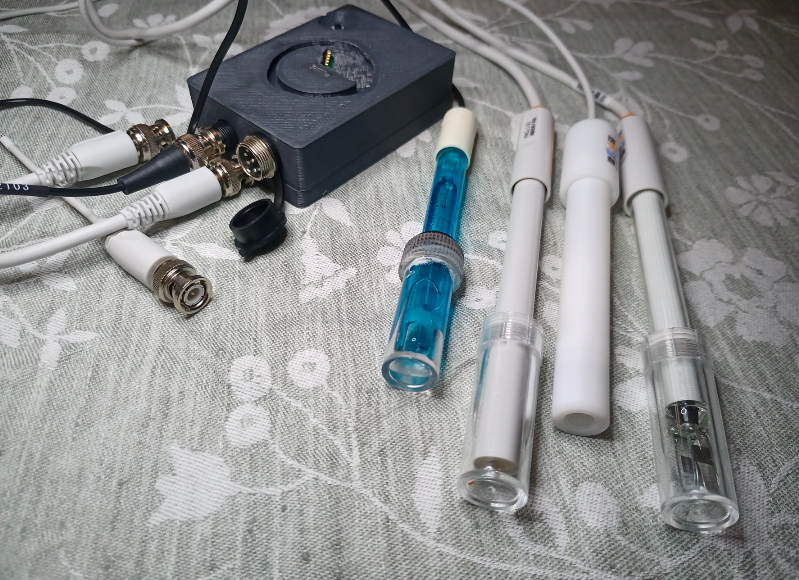 Figure 9, Ion Seletive Electrodes that can be used with xSpectrolum+; from left to rigth: pH, NO3-, NH4+ and electric conductivity.
Figure 9, Ion Seletive Electrodes that can be used with xSpectrolum+; from left to rigth: pH, NO3-, NH4+ and electric conductivity.
VIS/NIR/MIR addon spectral sensors
The main spectral sensor of v080 of xSpectrolum+ is etiher in the VIS or NIR spectral range. Through the external GX16 plug it is, however, possible to add an additional spectral sensor covering complementary spectral ranges, inluding multiband mid-IR (MIR) wavelenghts.
For version 080, broad band filter based spectral sensors from AMS have been tested. These sensor do not extend the spectral range beyond the Hamamatsu sensors, but can be used as a complement or for evaluating the prediction power of an alternative (cheaper) sensor configuration.
Figure 10 shows an attached AMS AS7263 6-channel NIR sensor mounted in its own stand-alone muzzle. The mounted breakout board is a SparkFun Spectral Sensor Breakout - AS7263
. Figure 10, SparkFun Spectral Sensor Breakout - AS7263, mounted as a stand-alone 6-band NIR sensor with its on muzzle.
Figure 10, SparkFun Spectral Sensor Breakout - AS7263, mounted as a stand-alone 6-band NIR sensor with its on muzzle.
Other probes
There are some additional, miscellaneos probes that can also be attached using the GX16 plug of the xSpectrolum+. For v080 we have tested gas-sensor of the MQ type, and a capacitive soil-moisture probe.
MQ gas probes
The series of MQ gas sensors, availbale from several producers and vedors, include both sensors for more general air pollution detection and sensors for particular gases. Some of them more common gas sensors include:Figure 11 illustrates 10 gas sensors, of which 9 in the "naked" form in which they are usually delivered and 1 (MQ-4 methane) enclosed in a 3D printed shell and attached to the xSpectrolum+ GX16 plug. All the MQ gas sensors require a period of approximately 3 minutes of heating up before the signal stabilizes.
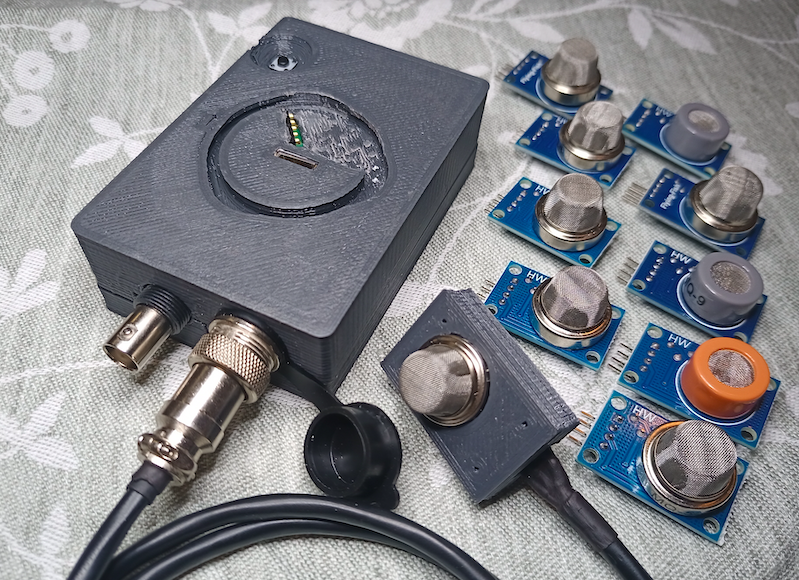 Figure 11, MQ gas sensors that can be attached to xSpectrolum+ via the GX16 plug.
Figure 11, MQ gas sensors that can be attached to xSpectrolum+ via the GX16 plug.
Capacitive soil-moisture probe
Also the capacitive soil-moisture probe (figure 12) is produced by a range of companies. It is a cheaper alternative comapred to the steel-pinned field probes, but can only sense the soil moisture.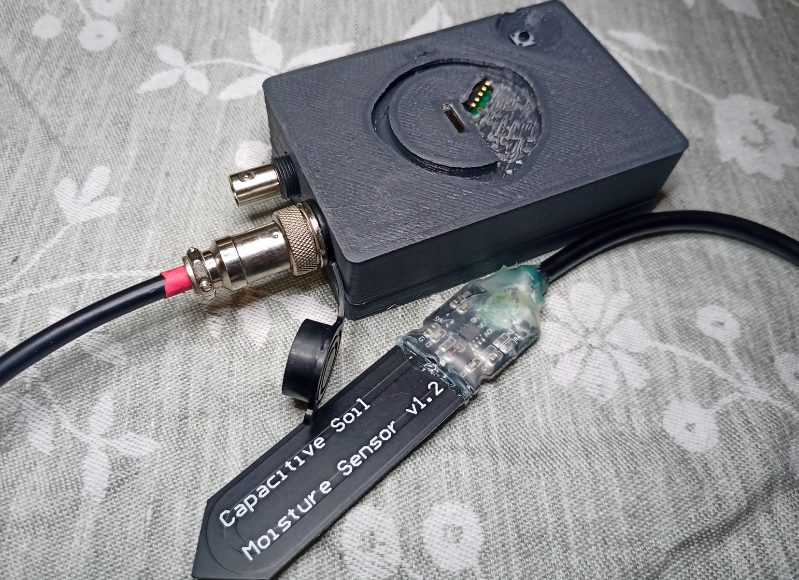 Figure 12, Capacitive soil-moisture probe attached to xSpectrolum+ via the GX16 plug.
Figure 12, Capacitive soil-moisture probe attached to xSpectrolum+ via the GX16 plug.